Jean David NAU
| |||||||||||||||||||||
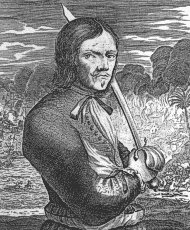 |
|
All filibusters without exception, be they French, Dutch, English, or Indian, are united unconditionally by their hatred of Spain and everything Spanish.
The Spaniards had almost exterminated the Indians, they had shown immense cruelty in Holland, and now they wanted, with the blessing of the Pope, to be unique and undisputed master of an entire continent, immeasurably rich. For these reasons the buccaneers should feel be felt entitled to fight the Spaniards to regain their gold and money plundered and to appropriate it in due form.
Some were pushed by an extremely strong motivation, as said Daniel Monbars The Exterminator, Bartolomeo the Portuguese, or Roche Brasileiro known as Le Roc.
But one of the most famous buccaneer captains, even if famous for the worst reasons, is Jean David Nau, a.k.a. l'Olonnais, often named Lolonois or even Lolona. He arrived in his youth and had to undergo three years of slavery before being admitted into the society of buccaneers. The years he then experienced in the forest, with the constant danger of being taken prisoner by the Spanish lancers and to be burned alive, created boundless hatred against the Spaniards in him.
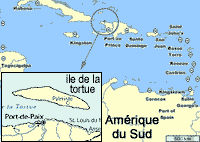
After years of hunting the young buccaneer decides to take the sea as filibuster.
Having become a pirate L'Olonnais demonstrated his courage and his decision, so that when the captain fell in battle, would be elected captain. Despite several takes would lose his ship in a storm. However his reputation as pirate captain allowed him, with the support of the French governor of the Tortuga Island, (map) to quickly equip a new unit.
Nau escapes death ... in smearing of blood!
After several good seizures he wrecked his ship near Campeche (see map). L'Olonnais had acquired such a reputation vis-à-vis of cruelty to Spanish prisoners and ships that all cities were fighting against him to the last man. When the Spaniards were flushed out after the sinking, they cut down all the crew. L'Olonnais escaped death by smearing himself with blood and hiding under dead bodies. From the start of the Spaniards he dressed in a Spanish uniform and arrived at Campeche, convinced some slaves with whom he grabbed a canoe and rowed back to the Tortuga Island. And again, l'Olonnais managed, with the help of the governor, to arm a new ship. While the Spaniards were still celebrating their victory over a pirate as they feared, l'Olonnais already on his third ship awaited the Spanish galleons to Havana.
The great seizure of Maracaibo
This is with Michel Basque, another great leader filibuster, when l'Olonnais began in 1666 the first great expedition of filibusters against the South American continent. The two pirates gather for the campaign with 8 sailboats and a landing force of 650 men under their command. On the way to Maracaibo, the destination of their raid, they make some good catches, including a large Spanish sailing ship loaded with cocoa and 300,000 silver talers.
Maracaïbo (see map) is located at the end of the lake of the same name in Venezuela, connected by a narrow channel to the sea. The channel is defended by a fort. L'Olonnais and Le Basque land their troops out of the range of the guns of the fort and Storm. Then they make their way into the channel and attack the city, which then had 4,000 inhabitants, and which fiercely defends. While they are still busy plundering, buccaneers learn that a Spanish detachment was sent as reinforcement. L'Olonnais walks to meet the troops with a group of 380 men, and tears them to pieces near the small town of Gibraltar. The Spaniards lose 500 men, while buccaneers contribute only 40, and 30 are wounded. L'Olonnais stays in the city of Gibraltar for six weeks, loots the city, and makes a rich booty. But an epidemic breaks out in the ranks of hackers, they set the city on fire, and return to Maracaibo, which they plunder out again, this time dramatically and entirely. The buccaneers' booty consists of about 260,000 pieces-of-eight and about 100,000 crowns, objects of worship and jewelry.
[pub]
After the capture of a city, why not take a whole country ?For the next shipment l'Olonnais tries to devastate and plunder an entire country, the Spanish Nicaragua. Successful in Maracaibo, he is quick to gather 6 ships and 700 buccaneers. The first goal of the campaign is the Cape Gracia a Dios, but the flotilla is taken by a storm and currents wash the buccaneers into the Gulf of Honduras. They decide to 'clean' the coasts of the Gulf - to plunder them until the weather allows them to continue their expedition. Their victims are small towns of turtle fishermen, generally Indians. By destroying their huts, but mostly by flying canoes, they undermine the foundations of the existence of these Indians. The booty filibusters is thin, but their hatred among these men grows more powerful.
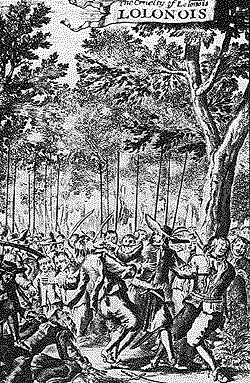 Nau l'Olonnais demonstrated great cruelty.
Nau l'Olonnais demonstrated great cruelty.Their primary prey of some importance is a Spanish boat armed with 20 guns, Puerto Caballo. L'Olonnais decides to walk towards the interior. It forces the prisoners to serve as guides to the city of San Pedro. Progress is difficult for pirates not only because of natural barriers, but also because of the constant attacks of the Spaniards who were informed of the Olonnois projects. During this march reports Oexmelin, l'Olonnais exercising cruelty against the Spanish prisoners is usual for him:
"He would routinely pull out and cut to pieces the tongues of people who confessed anything under torture. If he could, he would have liked to do the same with all Spaniards. It often happened that a few of these unfortunate prisoners under torture promised to show where their compatriots were hiding with their wealth. Then, if they were no longer found there, they died a more cruel death than their peers."
Oexmelin even says in his book that l'Olonnais one day opened a Spanish chest with one swing of a sword and snatched the still beating heart.
The conquests are scarce and difficult ...
After strong resistance of the Spanish soldiers San Pedro falls into the hands of pirates. But most people have already fled and had time to make their belongings safe. Without a big booty l'Olonnais sets fire to the city and heads back to the coast feeling weakened. While dissatisfaction is high among pirates after this long period without success and very costly in human lives, l'Olonnais dangles the hope of making a fortune, yet manages to keep his men in hand. When the expected Spanish ship finally arrives after 3 months, it turns out to be a difficult opponent with 41 pieces of cannon and 130 men. But the pirates want their loot and attack nevertheless. While large Spanish buildings are on fire, the buccaneers approach the other side in four canoes and take it. But neither gold nor silver, the Spanish ship is loaded with paper and steel. This new disappointment is so strong that the buccaneers lose their cohesion. Part of the troops restarts at Tortuga under the command of a newly elected captain Vauquelin. The second part under the command of Pierre Picard continues their quest of looting regardless, moreover, with little success. L'Olonnais leaves with 300 men for the Gulf of Honduras, and awaits seizure that never happens. Luck leaves the captain happy so far.
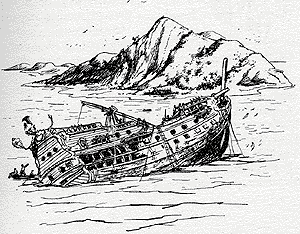 The end of Nau
The end of NauHe failed his ship on a sandbank. The crew was starving. Despite all the efforts (we land the guns and rig), the ship did not call afloat. For 6 months l'Olonnais had to defend them against the incessant attacks of the Indians with then only 150 men. With the flat-bottomed boats they had built he reached the mouth of the Rio San Juan which leads to Lake Nicaragua. But the Indians and Spaniards repelled them. He continued to sail along the coast of the Gulf of Darien. Down to earth to find food and fresh water he was taken prisoner by the Indians. They were definitely cannibals, because Oexmelin's story ends with these words: "They chopped him to pieces, roasted, and ate him."
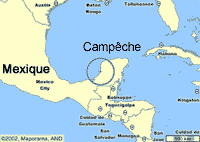
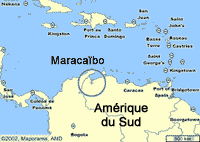
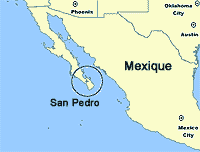
 French version -
French version -